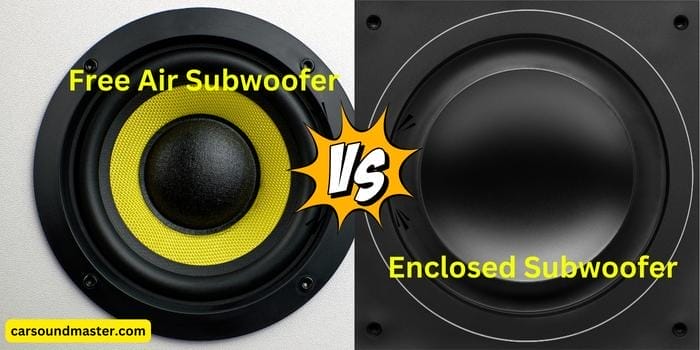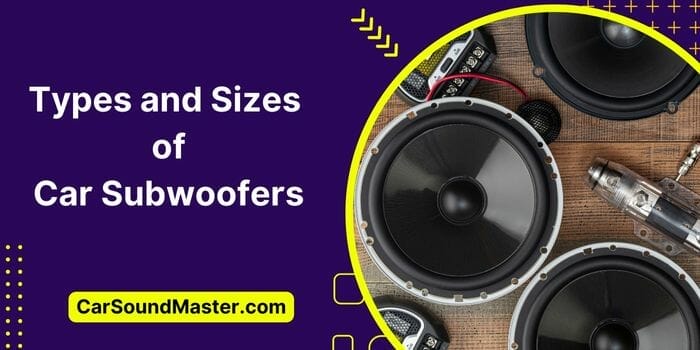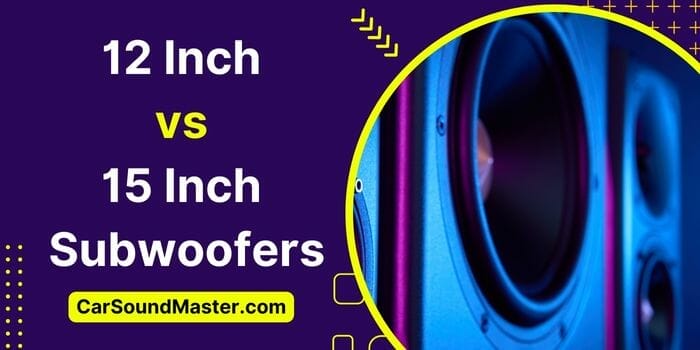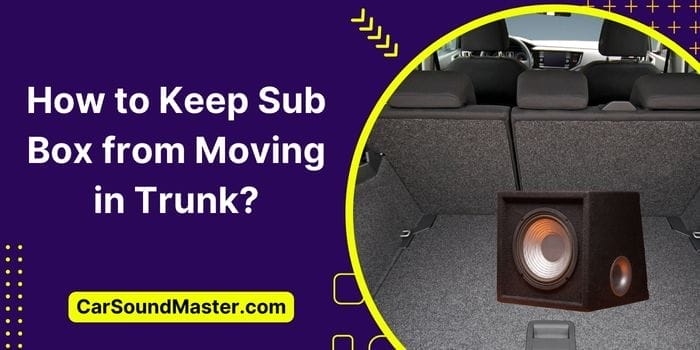Free Air Subwoofer Vs Enclosed Subwoofer – The Best Unveiled
Subwoofers are, though, speakers specifically designed to satisfy your bass craves, not all of them throw that felt-in-the-gut kind of impact.
So if you’re so much into and too choosy about the bass-bang in your music, deciding on a sub’s type tailor-made for your needs should always be one of your most climacteric decisions.
The two basic categories for you to choose a subwoofer for your car are either free air subs or enclosed ones.
Free air subs are great space savers, economical at power requirements, and relatively inexpensive as well.
However, their bass is not as tight, impactful, and precise as that of enclosed subwoofers which rather eat up much more space, power, and bucks.
So which one of the two is going to be your partner in crime? I have the answer for you; keep along.
Free Air Subwoofer vs. Enclosed Subwoofer
Subwoofers are either free air or fall under the wide canopy of enclosed ones. The battle between the two though never as such ends, the merits and demerits of each category make it somewhat easy for enthusiast audiophiles to finally land on one.
Here’s a detailed comparison.
Free Air Subwoofers
As is obvious through the name, a free-air subwoofer is just another speaker on your car that needs no box or enclosure to operate but is particularly engineered to throw only low-frequency sounds – the bass. These fall into the passive subwoofers sub-category and require a separate amp to play.
Free air subs use the car’s interior space as an enclosure and usually go on to stick to your car’s rear package shelf.
However, that’s not any standard, and you can install them anywhere you deem perfect, for example, in your vehicle’s doors too – quite uncommon though.
Advantages of Free Air Subwoofers
Some of the biggest advantages that make free air subs worth spending your bucks include:
They are Space-Savers
Because free air subs, like any other car speaker, don’t need any enclosing, they help you a lot with saving space in your vehicle. So if you’re a bass-mad person with a small car or limited space, these compact gimmicks should ideally be your bet.
The sans-box nature of free air subs makes them easily install anywhere on your car – no matter how tight the place.
Cheaper and Low-Priced
Free air subs come quite inexpensive compared to enclosed ones, and the reasons are straightforward for this – they don’t come with add-on features like enclosures or built-in amps, etc.
Much Belted Power Needs – Higher Efficiency
Free air subs are superbly economical in power consumption and come with much lower power ratings than enclosed subs.
That’s because they are engineered to work best in open-air environments so their voice coils, like that of any other driver, need much less power to move the air. If placed and tuned perfectly, a free air sub can also sound excellent.
Demerits of Free Air Subs
As with the pros, there are some cons to getting these subs as well. For example:
Less Tight, Less Impactful, and Poor Bass
No enclosure for a subwoofer means not as punchy and impressive bass as you’d expect from this driver. That’s because the lack of enclosing means no pressure whatsoever on the air waves making for higher frequency escapes.
The sound signals thus easily besprinkle the surroundings and that’s why free air subs may get a lot flat and sloppy while trying to pop out.
Tuning a free air sub perfectly is also not that easy as you’d need a lot of knowledge of acoustics, space-gain effect, measurements, etc., to make for optimal mounting.
Louder but Out of Tune
Besides being less accurate and less punchy, free air subs also tilt focus more on the SPL than SQ. Upon reaching the resonant frequency, they tend to be more intense and louder than clearer making them lose shape and often go off-color, off-tune.
You can also read: Types and Sizes of Car Subwoofers [New Researched List]
Enclosed Subwoofers
These are the subwoofers that come sealed in proper enclosures off the manufacturing belt. Enclosed subwoofers are either active or passive. The active ones additionally boast a built-in amp into the enclosure as well, whereas the passive subs need a separate/aftermarket amplifier.
Enclosed subs also come in a variety of designs including sealed (acoustic suspension), ported/vented (bass reflex), infinite baffle, bandpass (isobaric), transmission line, horn-loaded, tapped horn, etc. Two of the most widespread subwoofer enclosure types are, though, the sealed and ported subs.
Sealed Enclosures
Sealed enclosures (also known as acoustic suspension encl.), obviously, are fully sealed cabinets with no vent or port of any kind. If built properly, these are the most accurate sounding enclosures with their airtight environment acting like the limiting spring to the cone movements.
They have quite shallower low-frequency roll-off rates measuring at around 12dB/octave. This type of enclosure flaunts lesser phase rotation and reduced time-domain ringing, which ultimately translates into a more accurate, and superbly tight and definite frequency response.
Ported/Vented Enclosures
Also known as bass reflex cabinets, these enclosures feature one (or more) vent(s) in them for in/out air movements to reinforce low bass response. The hole allows the rear sound signals to conjoin those off the speaker’s front for better and increased overall results esp. when more and louder bass is required like that in hip-hop or raps.
They flaunt twice the amount of bass roll-off reading at 24dB/octave. Vented boxes are more efficient than sealed given you connect both with exactly the same amp. However, they’re quite complex to build.
Benefits of Enclosed Subwoofers
Both sealed and ported as well as all other types of enclosed subs are way superior at what they are designed for – the bass.
Emphatic, Tight, and Accurate Bass Response – Sealed Cabinets
When it’s about free air subwoofer vs enclosed subwoofer sound quality, the latter is a winner by miles. More specifically, the sealed sub cabinets are masters at throwing some real earthshaking, punchy bass.
Their airtight constructs are such that these subs move more air on the cone’s outer reef than the inner surface. You should ideally expect a tad bit flat (not very loud) but exceptionally tight and deep bass extension as well as more crisp and clear individual beats.
Roaring, Thundering, and Booming Bass – Ported Enclosures
The ported sub cabinets are though more adept at those roars and thunders in the bass. The port in the enclosure volte-face the rear signals and adds them up with those coming from the speaker’s front, making the bass loud and booming.
Ported subwoofer enclosures are great if you’re up for a tailgating competition and want more marks for richer and at the same time louder bass. But to match the bass-heaviness of a sealed subwoofer box, a ported cabinet should be made much bigger than its sealed counterpart.
Disadvantages of Enclosed Subwoofers
The flaws with getting enclosed subs include:
More Space Consuming
Enclosed subs are not ideal for smaller spaces like those less spacious Hatchbacks or Sedans or even similarly cramped HT setups. Their cased constructs always want you to sacrifice more space for them, so all the rest of the miscellany on your car’s rear shelf will be out.
Higher Power Requirements
Compared to their free air counterparts, the enclosed subs always have more press and pressure on their voice coils, thus optimally moving the air does put an extra toll on them. That said, a sealed subwoofer cabinet is the most power-hungry of the two. You always need more powerful amps to let them work at full throttle.
Much Pricier
You know, all great things come with a price. The cabinet-closed builds of these subwoofers not only amplify their bass performance but also help protect them from injuries and bruises caused by any sort of use-case scenario.
So that should understandably increase the prices of cabinet subs compared to the free air ones. That said, active sub-enclosures are the most expensive of the lot due to them boasting built-in amps as well.
Got the Differences? If Not, Here’s a Recap
Free air subwoofers don’t have much fuss in them; they are what their name suggests.
There may be differences in them based on price points and manufacturers, but end of the day, a free air sub is just another usual open-air speaker; a speaker (with solo low-frequency driver) that needs no cabinet whatsoever and can stick onto any sort of baffle (i.e. car’s parcel shelf, boat’s deck) with some air space to its back.
Because these are specifically engineered drivers for bass frequencies only, free air subs do superbly well for just the basic bass gaps in your vehicle’s surround sound. However, they get flat and sloppy when you force them for that extreme hard-hitting, punchy impact.
Alongside that, they may easily distort and constantly fall out on notes and melody as well.
On the other hand, enclosed subs come packed in cabinets and are of different types. Whichever type, they have much better bass performance than the free air subs. They output more profound bass and more emphatic beats as well as exhibit a perfect show of depths and booms where optimally required.
Conclusion – The Better of the Two?
All things said and done, the decision regarding the first-choice go-to option entirely depends on everyone’s personal preferences and the available resources, of course.
If someone is from the bass camp where only punchiness, depth, and quality of beats are preferred, he/she should definitely go for an enclosed sub. However, if the person is tight on budget, has a smaller car with cramped spacing, etc., he/she’d surely give it a second thought.
On the contrary, if a person is from the camp where it’s all about “just somehow filling the bass gaps”, the free air subs should be his/her best bet.
Rest, the “free air subwoofer vs enclosed subwoofer” thing goes on as it’s all about the sheer subjectivity involved in the music matters.







